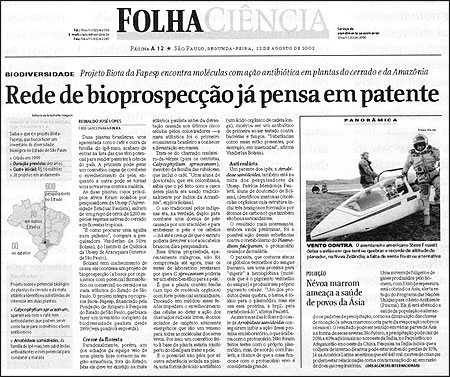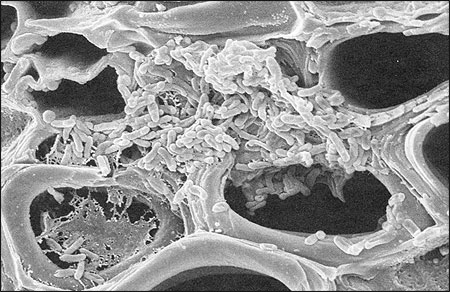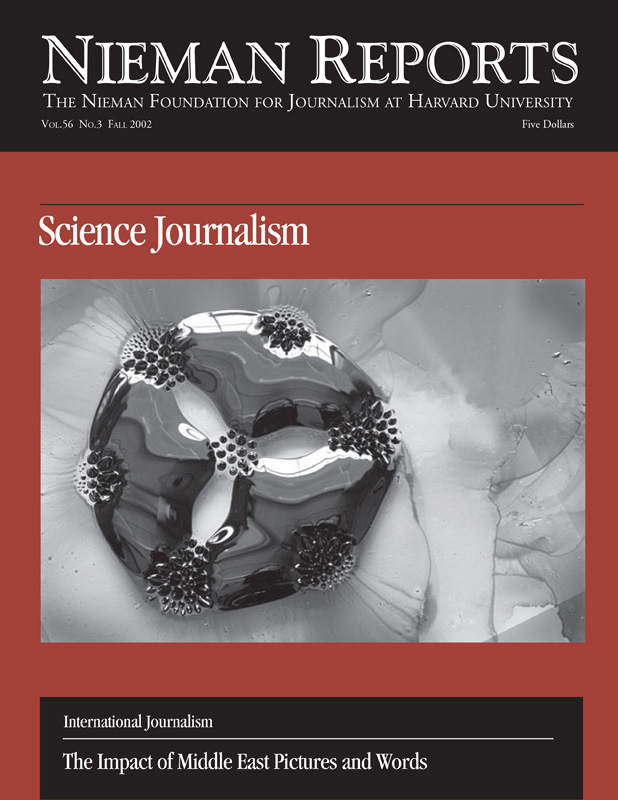
A story from the science page of Folha de São Paulo in Brazil.
This year two major events suggest a coming of age for South American science journalism and for its achieving international quality standards. In November, the Third World Conference of Science Journalists will take place in Brazil. And earlier in the year, two Latino editions of the most traditional U.S. science magazine, Scientific American, were launched: Scientific American Latinoamérica is published in Spanish, printed in Mexico, and distributed in countries such as Argentina, Uruguay and Colombia; and Scientific American Brasil, written in Portuguese, is now available in Brazil.
What we might conclude from all that is happening is that there is widespread demand in South America for news and information about science and enough expertise in science journalism to provide it, as well. However, this is not quite the case. Here’s why.
Currently, the Latino editions of Scientific American are hiring almost as many translators as journalists, if not more. (It is true, however, that the Brazilian publisher, Alfredo Nastari, has promised to fill the news hole with 50-70 percent domestically researched stories.) The fact is that the science writing jobs on this continent are few and vanishing, and this means that young journalists do not have the incentive to choose the science beat and to put in the many extra hours of classes and readings required for such specialization.
A typical science desk of a South American daily newspaper employs two to five journalists, although two is more typical than five. At my newspaper, Folha de São Paulo in Brazil, I am the editor, and I have an assistant editor and one reporter, down from three reporters in March 2000. This reduction in reporters is a result of cost-cutting forced by the continuing economic crisis in Brazil. Nevertheless, our small team remains responsible for covering the natural sciences and putting together a daily page (up to 50 percent of which might be taken by advertisement) in the first section, just after the op-ed, national and international affairs—a very prominent location in a Brazilian newspaper.
La Tercera in Chile, for example, relies on a staff of five science journalists. However, at that paper, these journalists might also report on such subjects as health, computers, environment and society. This mixture of expected expertise pushes them dangerously close to the broad category SMEERSH (science, medicine, energy, environment, research, and all sorts of other sh—.), so named by Dorothy Nelkin in her 1987 book, “Selling Science: How the Press Covers Science and Technology.” One can hardly speak of specialization under such circumstances.
South American science journalists struggle hard to improve their background in natural sciences, but few opportunities are readily available. What makes this difficult is that in many South American nations (including Brazil and Chile), journalists are required by law to study journalism before going into the profession. Those who major in natural sciences and have a gift for writing are not allowed to join news staffs, and specialization courses are seldom available. In Brazil, it wasn’t until 1999 that the São Paulo State University of Campinas (Unicamp) introduced a pioneering course of study in science journalism at the graduate level.
RELATED ARTICLE
"Reporting Science Means Looking For Cautionary Signals"
- Boyce RensbergerOften, South American science journalists in search of specialization go to a foreign country to study. I took this route twice in the past 13 years. In 1989, I went to Germany with a fellowship from the Krupp Foundation for internships in science media outlets such as Bild der Wissenschaft and Kosmos. In 1997-98, I went to Harvard as a Knight Latin American Nieman Fellow. Less than two years later I was lucky enough to get a mini-fellowship from the Knight Science Journalism program at MIT to attend a very productive one-week Genes & Cells Boot Camp put together by Boyce Rensberger. It is probably more than a happy coincidence that two out of 10 recently named 2002-2003 Knight Fellows at MIT come from Brazil, Ruth Helena Bellinghini and Alessandro Greco. Covering annual meetings of the American Association for the Advancement of Science have been very useful crash courses for Latino science writers, as well.
Because of seeking such training, many science journalists working for mainstream media outlets in South America are able to perform as good a job in science reporting as their counterparts in North America and in Europe. With similar academic backgrounds and a good command of the English language, they have access to the same sources through Web sites such as http://press.nature.com or www.eurekalert.org that are maintained by peer-reviewed and indexed journals. The access-restricted and embargoed press digests provided weekly via e-mail by these journals usually indicate all kinds of contact information to reach the leading authors of scientific papers throughout the world. Because these alerts arrive a week before publication, there is time to report the stories well. And because we share these similar conditions for journalistic research, the result is often similar science coverage.
This way of covering science has its downside, too. South American science journalists are often criticized by local scientists for not paying enough attention to research carried out in their own countries, and the criticism is to a great extent well deserved. There are too few stories about Brazilian scientific research in Brazilian newspapers and magazines, and this is likely true in much of South America. This is caused not so much by sloppy reporting but because of a general deficiency in the circulation of scientific information inside of these countries.
There are no journals published in Spanish or Portuguese that compare with publications like Nature or Science, nor is there a Latino EurekAlert to bring news of what is being done in South American labs to science journalists. And so the public does not receive this information, either. To gather such material, reporters would have to keep tabs on dozens of scattered labs, universities and research institutes, and this is not practical to do given our staffing. For us, it is easier to learn about a newsworthy piece of research done by a local scientist when the findings are published in, for example, the PNAS—Proceedings of the National Academy of Sciences (U.S.)—than to rely on a hint or note from the press office or PR staff at the research institution. Here, there is just no tradition of working with journalists in this way, in part because research funding is not as tightly linked to public mechanisms of control as it is in more developed countries.
On those occasions when South American researchers publish their findings in a major article in an internationally renowned journal, the local press tends to overcompensate. It was the case with the genome sequencing of Xylella fastidiosa (the first plant pathogen to have its whole DNA sequence unveiled) by a Brazilian team. These findings made the front page of Nature in July 2000. In the Brazilian press, rivers of ink flowed in praise, as if our countrymen had come close to the feat of sequencing the human genome, announced less than a month before by President Bill Clinton and Prime Minister Tony Blair.
Additional hurdles for science reporting also turn up in the communication with researchers themselves. Scared off by previous shocking experiences with unprepared reporters and not at all accustomed to addressing the general public in search of recognition for the social relevance of their workings in the lab, South American scientists can be more difficult sources than foreign scientists. American researchers, in particular, always seem ready for interviews and for the chance to boost the impact of their findings among the international scientific community (and, consequently, increase their citations in the database index of the ISI—Institute for Scientific Information.) This is a trick young South American researchers are learning pretty fast so, on average, the situation of media access is improving.
Even as the average level of science reporting in South America is improving, there remains a lot to be done. Quality newspapers are experiencing increasingly low circulation rates in highly populated countries with no more than two million copies being sold in Brazil, which has 170 million inhabitants. And science pages rank among the least read by subscribers; at Folha, the figure is about 20 percent. Too many readers complain they cannot fully understand science stories. And it is likely that even fewer would be able to recall them at all after a few minutes.
Experts on the public understanding of science are discussing the validity of scientific literacy (deficit) models in post-industrialized societies. These experts conclude that stuffing newspaper pages with science stories is not nearly enough to enlighten and engage the public in a true democratic debate about the uses, abuses and risks of modern science and technology. Nevertheless, this is clearly the case in South America; the word “deficit” summarizes what is not going on between the worlds of research and the public sphere. This is of great concern when one recognizes how often these nations’ policymakers are entangled by decisions that involve the complexities of issues such as transgenic foods, assisted reproduction technologies, genetic information privacy, and environmental disruption.
Given this need for understandable and accurate scientific information to underpin democratic public policy decision-making, South American journalists cannot wait any longer to progress from “good” science reporting to the kind of independent evaluation and criticism of science that the public needs and deserves.

Scanning electron micrograph, shown at about 4,000x magnification, of the bacterium Xylella fastidiosa, causal agent of the citrus variegated chlorosis, present in the xylem vessel of an infected sweet orange leaf. Photo by E.W. Kitajima (ESALQ/USP/Brazil).
Marcelo Leite, a 1998 Nieman Fellow, is science editor and Sunday science columnist for Folha de São Paulo (www.folha.com.br) in Brazil. Leite was the paper’s ombudsman from 1994 until 1996.



